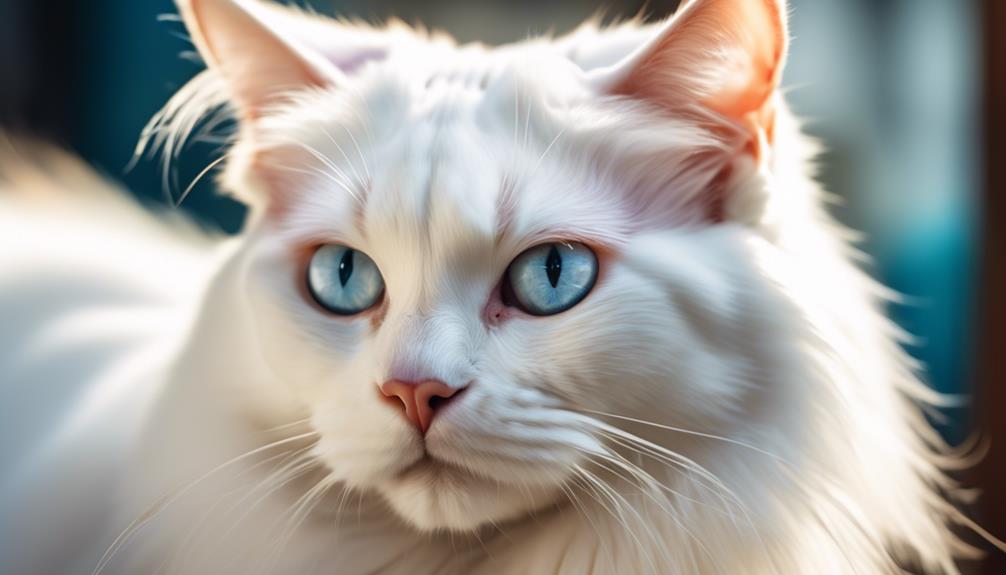
The Turkish Van cat breed is known for its striking appearance and unique characteristics.
The Turkish Van stands out among other breeds with its long, soft, and silky coat and water-resistant undercoat.
But there’s more to this captivating feline than meets the eye. From its intelligent and playful temperament to its intriguing history, there’s a wealth of information and characteristics to explore.
So, let’s dive into the world of the Turkish Van and uncover what makes it such a fascinating breed.
Key Takeaways
- Turkish Van cats have a medium size with a sturdy and muscular build.
- They have a semi-long, soft, and silky coat with water-resistant properties.
- Turkish Van cats belong to the natural breed group and have 12-15 years of lifespan.
- They are intelligent, playful, and affectionate cats with moderate to high exercise needs.
Origin and Size
The Turkish Van cat breed, originating from Turkey, is a medium-sized feline known for its unique characteristics.
These cats have a sturdy and muscular build, with males weighing 10 to 20 pounds and females weighing slightly less.
Their semi-long, soft, and silky coat is often described as waterproof due to its water-resistant undercoat.
This makes them excellent swimmers, so they’re sometimes called the ‘swimming cat.’ The Turkish Van’s coat comes in various colors and patterns, with the most recognized being the Van pattern, which consists of a predominantly white coat with colored markings on the head and tail.
This breed’s distinct appearance and playful, affectionate temperament make them a popular choice among cat lovers.
See another cat breed profile.
Ukrainian Levkoy
Breed Group and Lifespan
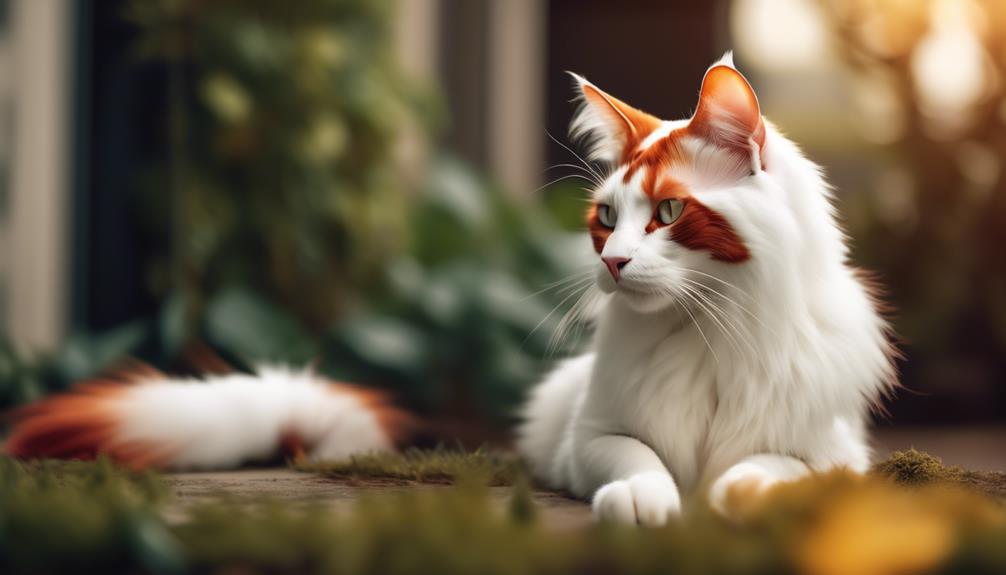
With a lifespan of 12-15 years, the Turkish Van cat belongs to the natural breed group known for its distinct characteristics and unique qualities.
This breed is known for its medium-sized, long, soft, and silky coat with a water-resistant undercoat.
Turkish Vans have an intelligent, playful, and affectionate temperament and require moderate to high exercise. They are relatively easy to train and only need regular brushing for grooming.
However, they are prone to certain genetic health conditions. To give readers a quick overview, the table below summarizes the key characteristics of the Turkish Van breed.
| Breed Group | Lifespan |
|---|---|
| Natural | 12-15 years |
Coat Description
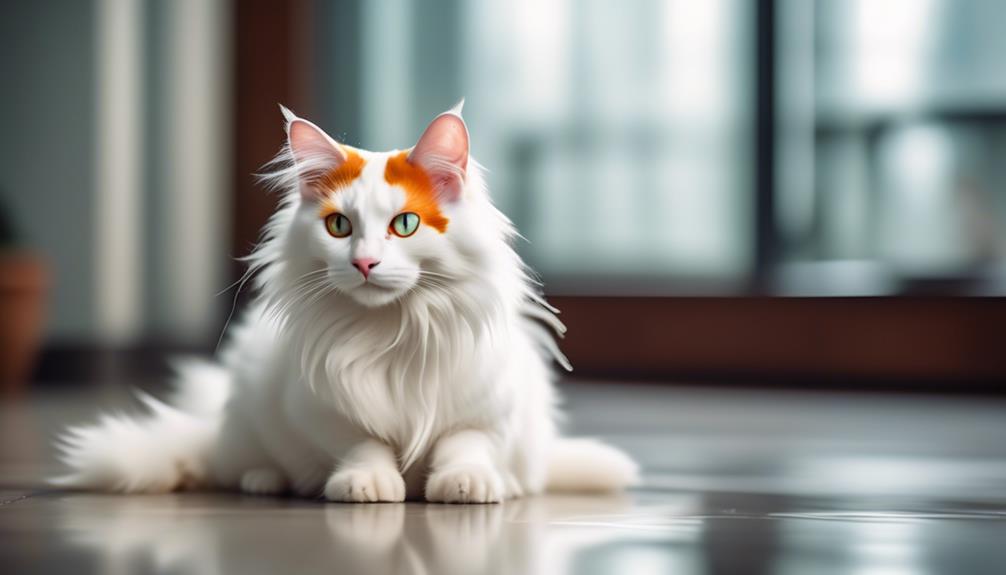
Moving on to the Turkish Van cat breed’s coat description, let’s explore the unique characteristics of their luxurious fur.
- The Turkish Van has a long, soft, and silky coat that’s a delight to touch.
- Their fur is water-resistant, thanks to a dense undercoat, making them excellent swimmers.
- The coat comes in various colors and patterns, including the distinctive Van pattern, which features a colored head and tail with a white body.
The Turkish Van’s coat isn’t only visually stunning but also serves a practical purpose.
Its water-resistant properties make it well-suited for the breed’s love of water activities. The soft and silky texture adds to the overall appeal of this beautiful cat.
Whether splashing in a pool or lounging on a sunny windowsill, the Turkish Van’s coat will captivate anyone who encounters it.
Temperament and Exercise Needs
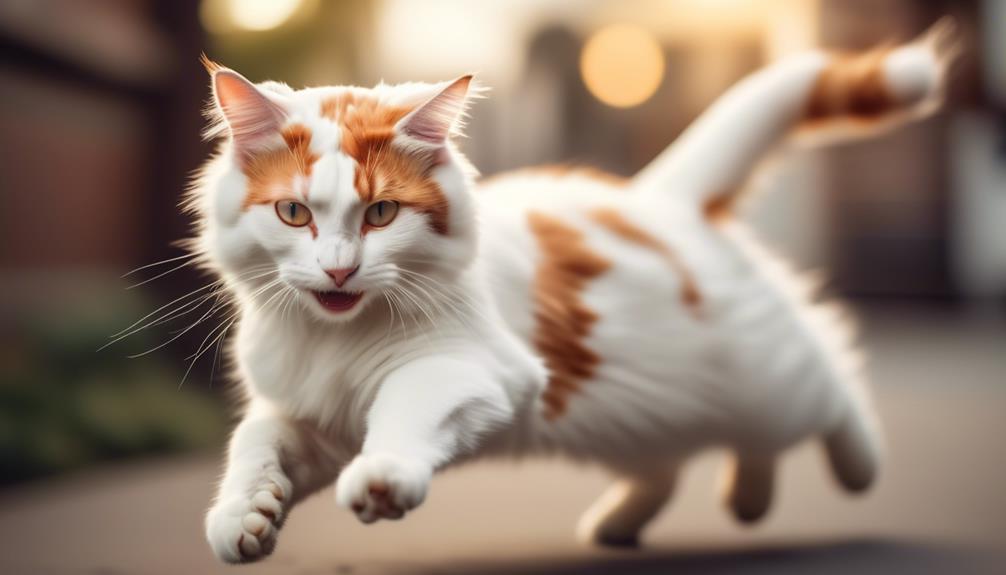
Turkish Van cats are known for their intelligent and playful temperament and moderate to high exercise needs.
These cats are highly active and love to play, so providing them with plenty of opportunities for physical and mental stimulation is important.
They enjoy interactive toys, puzzle feeders, and playtime with their owners. Turkish Van cats also have a curious nature and love to explore their surroundings. To keep them happy and healthy, providing them with a large, stimulating environment and regular play sessions is recommended.
Here is a table summarizing the temperament and exercise needs of Turkish Van cats:
| Temperament | Exercise Needs |
|---|---|
| Intelligent | Moderate to High |
| Playful | Moderate to High |
| Affectionate | Moderate |
| Curious | Moderate |
Trainability and Grooming Requirements
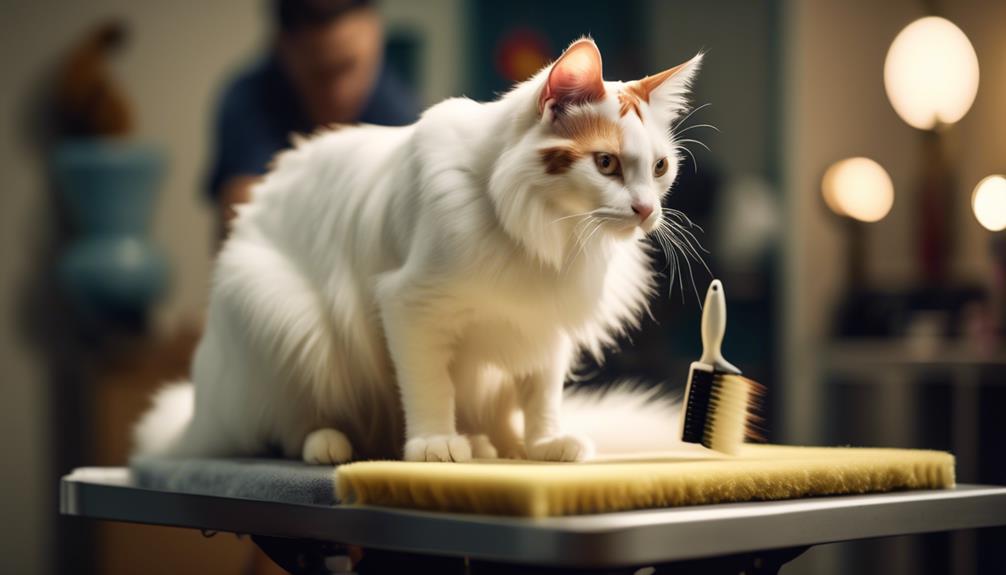
After discussing Turkish Van cats’ temperament and exercise needs, it’s important to understand their trainability and grooming requirements.
Turkish Vans are known to be relatively easy to train, making them a good choice for owners who want a cat that can learn tricks or respond to commands.
They’re intelligent and eager to please, which facilitates the training process.
Regarding grooming, Turkish Vans have a single coat with a silky texture.
They require regular brushing to keep their fur in good condition and to prevent matting. However, they shed very little except during spring and fall.
This means weekly combing or brushing with a slicker brush is usually sufficient to maintain their coat.
Genetic Health Conditions
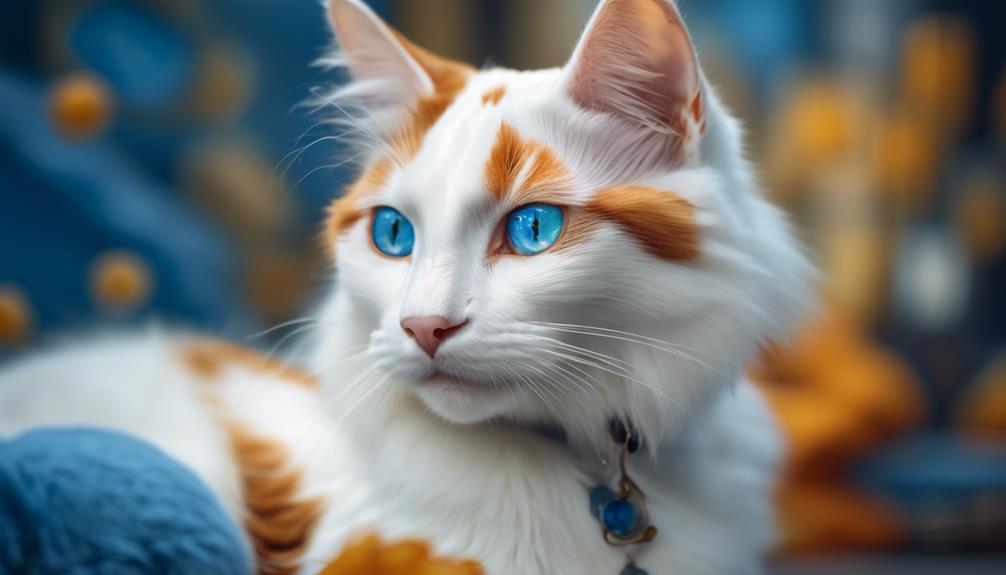
Genetic health conditions in Turkish Van cats can pose risks and require careful consideration by potential owners.
While the Turkish Van breed is generally healthy, a few hereditary health conditions can affect these cats.
One of the most common conditions is Autosomal Recessive Polycystic Kidney Disease (ARPKD), which can lead to the formation of cysts in the kidneys.
Another condition to be aware of is Hypertrophic Cardiomyopathy (HCM), a heart disease that causes heart muscle thickening.
It’s important for potential owners to be aware of these conditions and to work with reputable breeders who prioritize health testing and genetic screening.
Regular veterinary check-ups and a healthy diet can also help minimize the risk of these genetic health conditions in Turkish Van cats.
History and Legend
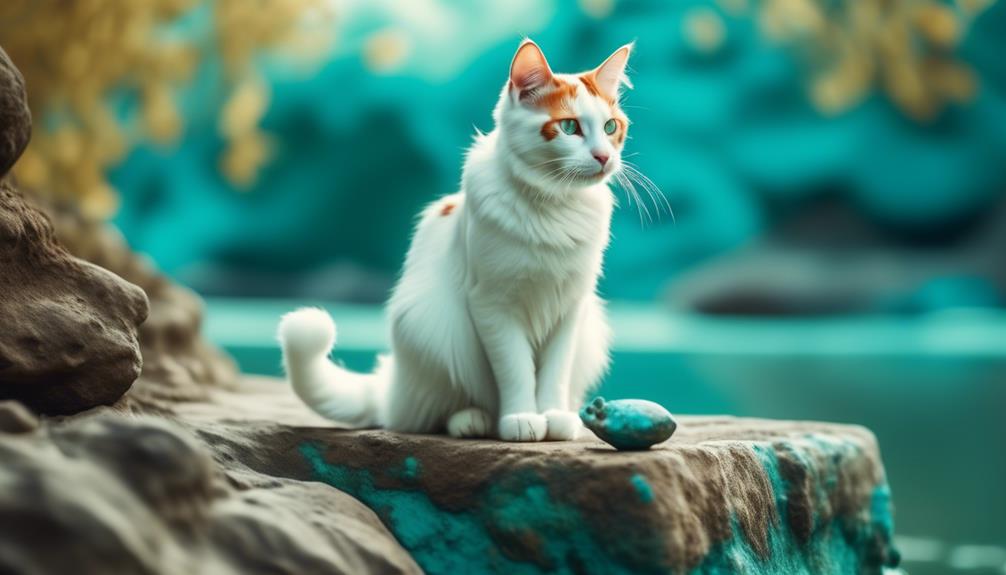
The history and legend surrounding the Turkish Van breed is steeped in mystery and intrigue.
Here are three fascinating aspects of their history:
- Known as the swimming cat, Turkish Vans are famous for their unique ability to swim. They’re natural-born swimmers and are often found frolicking in water.
- Originated in the Lake Van area: It’s believed that Turkish Vans originated in the picturesque Lake Van area of Turkey. The mountainous and rugged landscape of the region contributed to the development of their strong coat and muscular body.
- Legend of Noah’s Ark: According to legend, Turkish Vans swam ashore from Noah’s Ark, earning them the title of the ‘Ark Cats.’ Their striking spots of color are said to be a divine touch. This legend adds an air of mystique to their already captivating history.
These historical and legendary elements make the Turkish Van breed even more intriguing and unique.
Swimming Ability and Origin
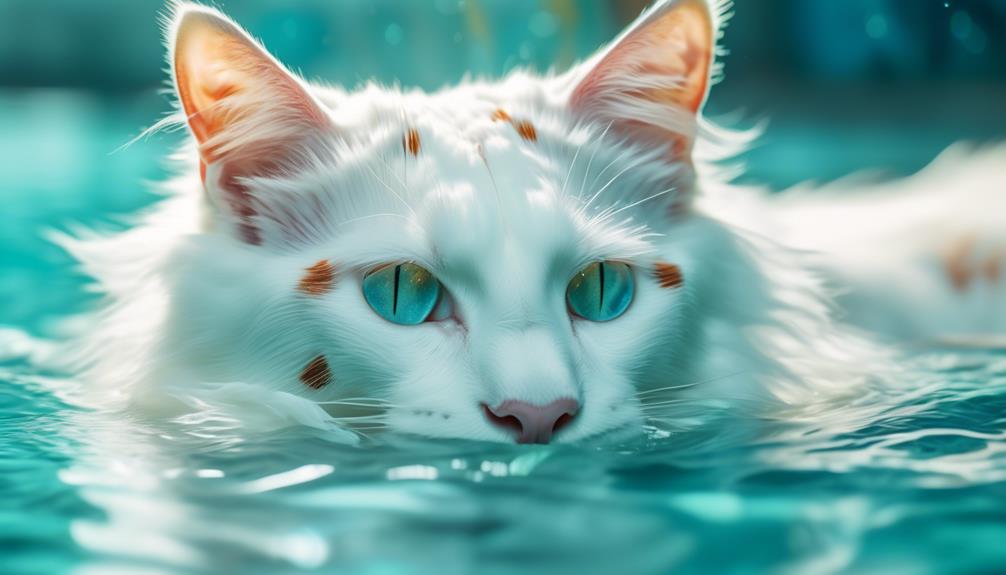
Turkish Vans are renowned for their impressive swimming ability, setting them apart from other cat breeds.
This unique characteristic is believed to have originated in the Lake Van area of Turkey, where these cats developed their exceptional skills.
The mountainous and rugged landscape of the region played a significant role in the development of their coat and body, making them well-suited for swimming.
According to legend, Turkish Vans swam ashore from Noah’s ark and were blessed with spots of color as a divine touch.
Their water-resistant undercoat and long, silky fur enable them to navigate through water effortlessly.
This remarkable swimming ability is just one of the many intriguing aspects of Turkish Vans’ origin and history.
Landscape and Coat Development
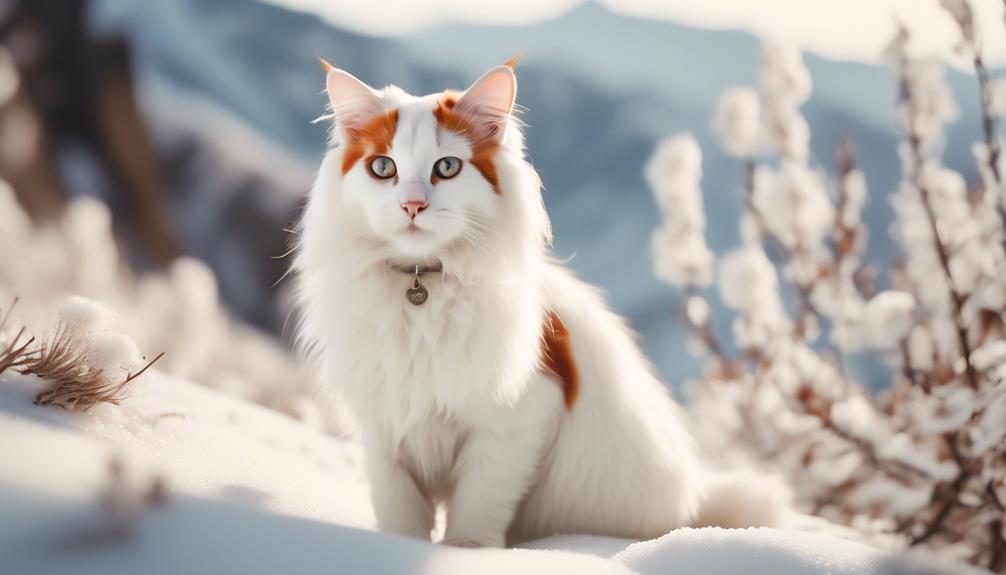
The mountainous and rugged landscape of Turkey’s Lake Van region played a significant role in shaping the coat development of Turkish Van cats.
The harsh environment and extreme weather conditions forced these cats to adapt and evolve, resulting in their unique coat characteristics.
Here are three ways in which the landscape influenced the coat development of Turkish Van cats:
- Dense and water-resistant coat: The long, soft, and silky coat of Turkish Van cats is designed to protect them from the cold and wet conditions of the region. Their naturally water-resistant fur allows them to stay warm and dry even when swimming in the lake.
- Color patterns for camouflage: The coats of Turkish Van cats often feature a distinctive pattern of colored spots, which helps them blend in with their surroundings. This camouflage is essential for hunting in the rugged landscape, allowing them to stalk their prey without being detected.
- Insulating undercoat: To cope with the region’s extreme temperatures, Turkish Van cats have developed a thick, insulating undercoat. This undercoat helps to regulate their body temperature, keeping them warm in the winter and cool in the summer.
Noah’s Ark Connection
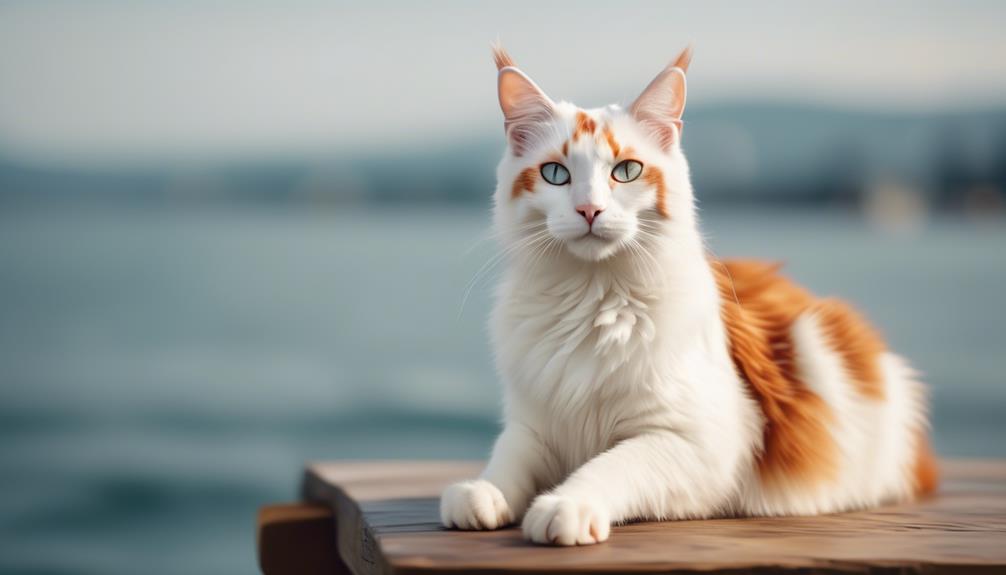
Having discussed the landscape’s influence on the coat development of Turkish Van cats, it is intriguing to explore the connection between these feline companions and Noah’s Ark.
According to legend, Turkish Vans swam ashore from Noah’s Ark, and their spots of color were believed to be a divine touch.
This connection to one of the most famous stories in history adds to the mystique and allure of the breed.
Although no scientific evidence supports this claim, it is a fascinating aspect of Turkish Van folklore.
Whether or not they truly sailed with Noah, Turkish Vans continue to capture the hearts of cat lovers worldwide with their unique beauty and charming personalities.
| Noah’s Ark Connection | Turkish Van Cats |
|---|---|
| – Legend says they swam ashore from the ark | – Known as the swimming cat |
| – Spots of color believed to be a divine touch | – Unique beauty and charm |
| – No scientific evidence to support the claim | – Captivating cat lovers worldwide |
| – Adds to the breed’s mystique and allure | – Charming personalities |
Divine Touch and Color Spots
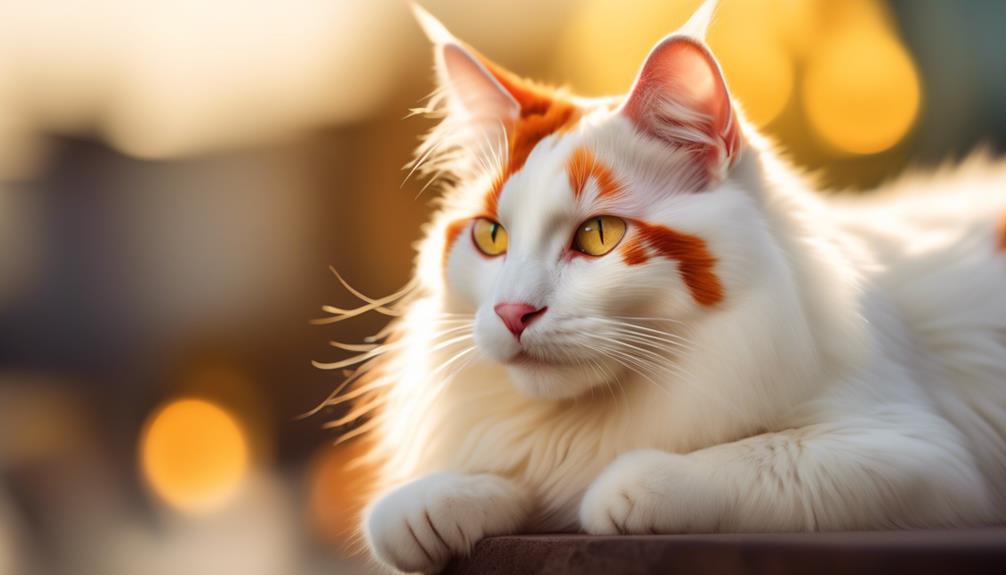
Believed to be a sign of divine intervention, Turkish Van cats possess color spots that add to their unique beauty and charm.
These spots aren’t random but rather strategically placed on their bodies.
Here are three fascinating facts about the divine touch and color spots of Turkish Van cats:
- The color spots are typically found on their heads and tails, creating a striking contrast against their white coats.
- Each cat’s pattern is unique, with no two Turkish Vans having the same arrangement of color spots.
- The spots can come in various colors, including red, cream, black, or blue.
These color spots aren’t only visually appealing and serve as a distinguishing feature of this breed.
They add to the overall allure and elegance of the Turkish Van, making them truly stand out among other cat breeds.
Adopting Rescue Organizations
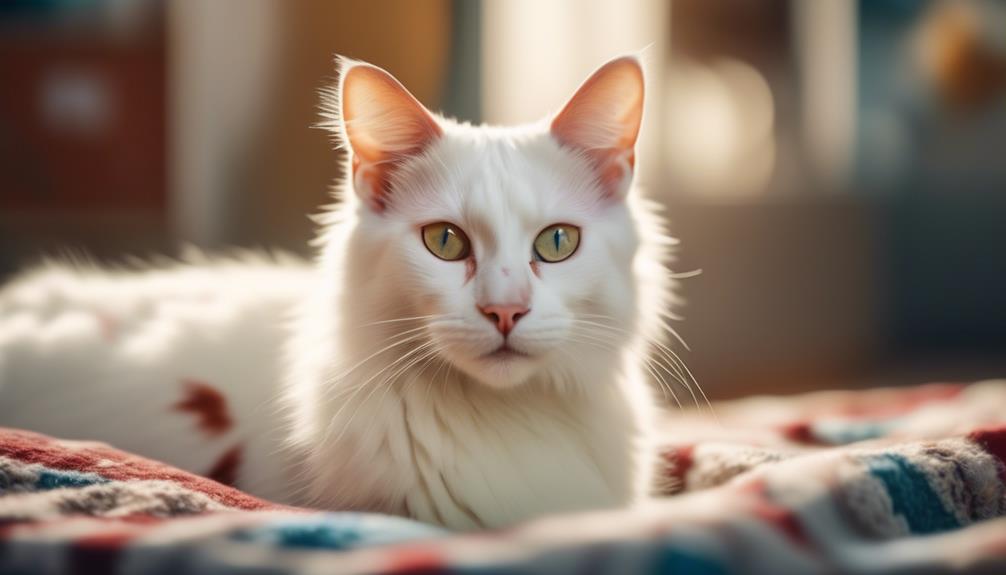
Adopting from rescue organizations is recommended if you’re considering adding a Turkish Van cat to your family.
Rescue organizations provide a chance for these beautiful cats to find loving homes.
By adopting from a rescue organization, you not only give a Turkish Van cat a second chance at life but also support the efforts of these organizations to rescue and care for abandoned and stray cats.
When adopting from a rescue organization, you can often find Turkish Van cats of different ages, from kittens to adults.
These cats are usually spayed or neutered, vaccinated, and microchipped, ensuring they’re ready to join your family.
Additionally, rescue organizations can provide valuable information about the cat’s personality, behavior, and any specific needs they may have.
Adopting rescue organizations is a wonderful way to give a Turkish Van cat a loving home while positively impacting their lives.
Choosing a Reputable Breeder
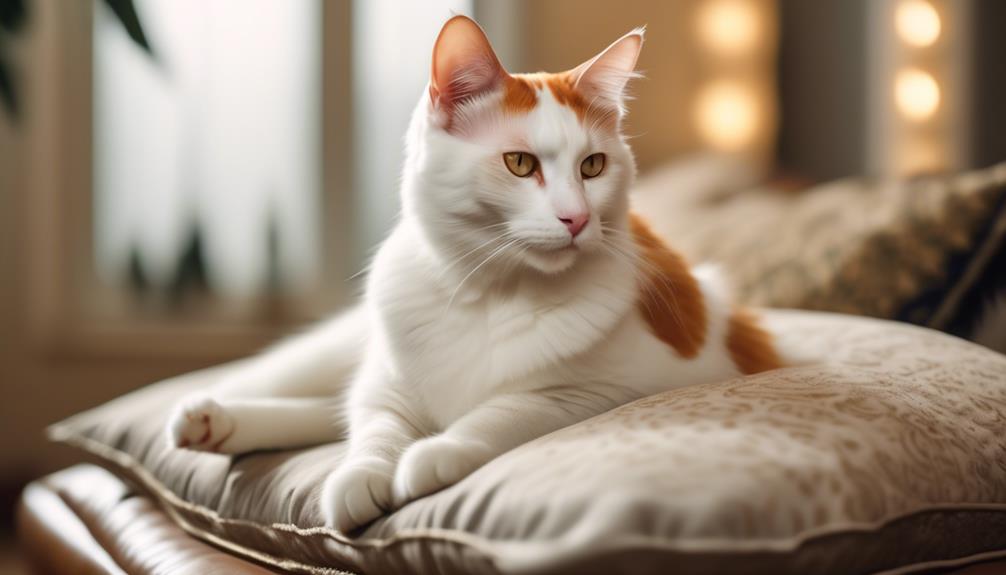
When choosing a reputable breeder for a Turkish Van cat, it’s important to prioritize thorough research on their practices.
This will help ensure that you’re getting a healthy and well-cared-for kitten.
Here are three key things to consider when choosing a breeder:
- Health and Temperament: Reputable breeders prioritize the health and temperament of their cats. They conduct proper health screenings and provide necessary vaccinations to ensure the well-being of their kittens. They also socialize the kittens from an early age, exposing them to different environments and people to ensure they grow up to be friendly and well-adjusted cats.
- Ethical Breeding Practices: A reputable breeder follows ethical breeding practices. They don’t overbreed their cats or engage in practices prioritizing quantity over quality. They provide a safe and clean environment for their cats and kittens and are transparent about their breeding methods.
- References and Reviews: Before choosing a breeder, check for references and reviews from previous customers. This will give you an idea of the breeder’s reputation and the experiences of others who’ve purchased kittens. Positive reviews and satisfied customers are a good indication of a reputable breeder.
Researching Breeder Practices

To ensure a Turkish Van kitten’s well-being, thoroughly researching a breeder’s practices is essential.
When researching a breeder, it’s important to prioritize their commitment to the health and temperament of their cats.
Reputable breeders will prioritize the well-being of their cats and won’t engage in unethical breeding practices.
This includes avoiding inbreeding and ensuring that their cats are properly socialized.
A responsible breeder will also provide adequate veterinary care for their cats, including vaccinations and regular health check-ups.
They’ll also be transparent about any known genetic health conditions within the breed and take steps to minimize their occurrence.
Ethical Breeding Practices
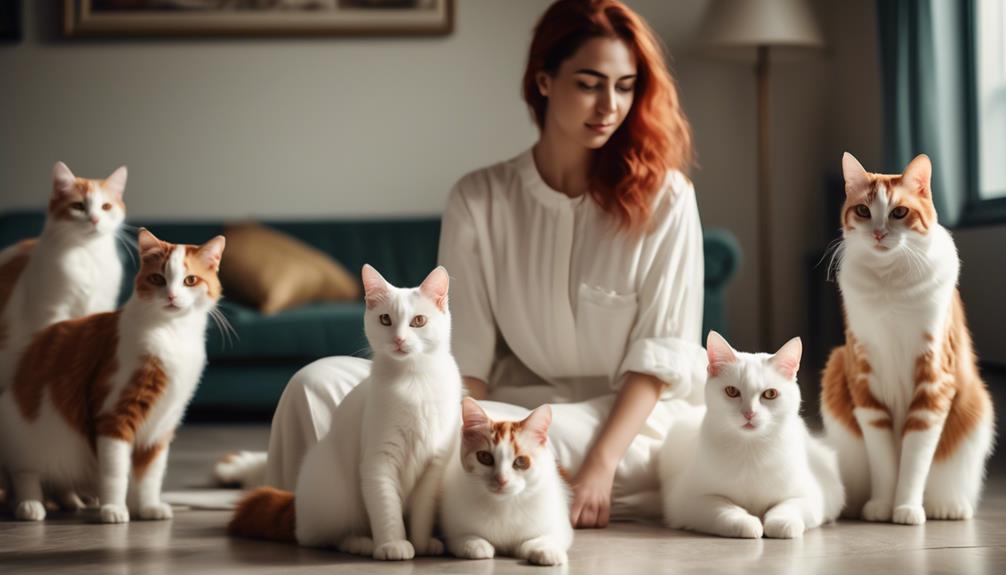
Thoroughly researching a breeder’s practices ensures that potential owners can make an informed decision and obtain a healthy and well-cared-for Turkish Van kitten, including understanding the importance of ethical breeding practices.
When considering a breeder, it’s important to prioritize those who adhere to ethical breeding practices.
Here are three key aspects of ethical breeding to consider:
- Health Testing: Ethical breeders prioritize their cats’ health and conduct appropriate health tests to screen for any genetic disorders or health conditions present within the breed.
- Socialization: Ethical breeders focus on socializing their kittens early, ensuring they’re well-adjusted, confident, and comfortable around people and other animals.
- Responsible Placement: Ethical breeders carefully screen potential owners to ensure their kittens are placed in loving and suitable homes, and they also provide ongoing support and guidance throughout the cat’s life.
Frequently Asked Questions
What Common Health Issues Should Turkish Van Cats Be Prone To?
Turkish Van cats may be prone to certain genetic health conditions.
Regular vet check-ups are recommended to monitor for any potential issues. Providing them with a healthy diet and proper care is important to minimize the risk of health issues.
Are Turkish Van Cats Good With Children and Other Pets?
Turkish Van cats are generally good with children and other pets. They have an affectionate temperament and are known to be playful and friendly.
Proper socialization and introductions are important for a harmonious coexistence.
How Much Exercise Do Turkish Van Cats Need Daily?
Turkish Van cats need moderate to high exercise daily.
They are active and playful, so engaging them in interactive play sessions and providing toys can help meet their exercise needs.
Do Turkish Van Cats Enjoy Being Groomed, or Is It a Struggle?
Turkish Van cats typically enjoy being groomed. Their silky, single coat requires weekly brushing, which can be a bonding experience.
However, individual preferences may vary, so it’s important to introduce grooming gradually and provide positive reinforcement.
Are Turkish Van Cats Generally Vocal or Quiet?
Turkish Van cats are generally vocal and enjoy communicating with their owners.
They use a variety of sounds to express their needs and emotions, making them quite talkative companions.
Conclusion
In conclusion, the Turkish Van is a captivating cat breed with a rich history and unique characteristics.
With their long, silky coat and affectionate temperament, they make wonderful companions for cat lovers worldwide.
It’s important to prioritize reputable sources when adopting or purchasing a Turkish Van ensuring their health and well-being.
By providing proper care and attention, you can enjoy this remarkable breed’s beauty and charm.




